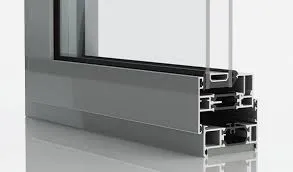aluminum window frame extrusion profiles
Aluminum Window Frame Extrusion Profiles A Comprehensive Overview
Aluminum window frame extrusion profiles have become a popular choice in modern architecture and construction, thanks to their versatility, durability, and aesthetic appeal. This article explores the characteristics, advantages, and application of aluminum window frame extrusion profiles.
What are Aluminum Window Frame Extrusion Profiles?
Aluminum extrusion is a manufacturing process that shapes aluminum alloys into specific profiles by forcing the material through a die. This technique allows for a wide range of designs and cross-sectional shapes, tailoring the profiles to fit various applications. In the case of window frames, these extruded profiles can be designed to accommodate multiple glass types, insulation materials, and styles, making them indispensable in contemporary building practices.
Advantages of Aluminum Window Frame Extrusion Profiles
1. Durability and Strength Aluminum is an inherently strong material that does not corrode easily. This makes window frames made from aluminum highly durable and capable of withstanding various environmental conditions, including harsh weather and UV radiation.
2. Lightweight Compared to other materials such as wood or steel, aluminum is significantly lighter. This weight advantage simplifies transportation, handling, and installation, ultimately reducing labor costs.
3. Aesthetic Flexibility Aluminum window frames can be manufactured in an array of colors, finishes, and profiles. This versatility allows architects and designers to create unique and visually appealing windows that complement the overall design of a building.
aluminum window frame extrusion profiles

4. Energy Efficiency Modern aluminum profiles can be designed with thermal breaks and insulation features that improve energy efficiency. This means that homeowners can enjoy improved thermal performance, leading to reduced energy costs for heating and cooling.
5. Low Maintenance One of the standout benefits of aluminum window frames is their low maintenance requirements. They do not need regular painting or sealing, and can be easily cleaned with soap and water.
Applications
Aluminum window frame extrusion profiles are widely used in residential, commercial, and industrial buildings. In residential construction, they are prevalent in the design of modern homes due to their sleek appearance and versatility. In commercial applications, these frames support large glass facades, allowing for abundant natural light while maintaining structural integrity.
Moreover, the use of aluminum window frames is increasingly found in energy-efficient designs, such as passive houses and green buildings. Their compatibility with insulation materials helps to meet stringent energy regulations and reduce the carbon footprint of modern constructions.
Conclusion
The popularity of aluminum window frame extrusion profiles is no accident; they offer a multitude of benefits that cater to the demands of contemporary architecture. With their durability, aesthetic flexibility, and energy efficiency, aluminum windows have positioned themselves as a preferred choice among architects, builders, and homeowners alike. As the industry continues to innovate, aluminum window frames will play a pivotal role in the future of building design, merging functionality with style to create enduring structures.
-
Wrought Iron Components: Timeless Elegance and Structural StrengthNewsJul.28,2025
-
Window Hardware Essentials: Rollers, Handles, and Locking SolutionsNewsJul.28,2025
-
Small Agricultural Processing Machines: Corn Threshers, Cassava Chippers, Grain Peelers & Chaff CuttersNewsJul.28,2025
-
Sliding Rollers: Smooth, Silent, and Built to LastNewsJul.28,2025
-
Cast Iron Stoves: Timeless Heating with Modern EfficiencyNewsJul.28,2025
-
Cast Iron Pipe and Fitting: Durable, Fire-Resistant Solutions for Plumbing and DrainageNewsJul.28,2025
-
 Wrought Iron Components: Timeless Elegance and Structural StrengthJul-28-2025Wrought Iron Components: Timeless Elegance and Structural Strength
Wrought Iron Components: Timeless Elegance and Structural StrengthJul-28-2025Wrought Iron Components: Timeless Elegance and Structural Strength -
 Window Hardware Essentials: Rollers, Handles, and Locking SolutionsJul-28-2025Window Hardware Essentials: Rollers, Handles, and Locking Solutions
Window Hardware Essentials: Rollers, Handles, and Locking SolutionsJul-28-2025Window Hardware Essentials: Rollers, Handles, and Locking Solutions -
 Small Agricultural Processing Machines: Corn Threshers, Cassava Chippers, Grain Peelers & Chaff CuttersJul-28-2025Small Agricultural Processing Machines: Corn Threshers, Cassava Chippers, Grain Peelers & Chaff Cutters
Small Agricultural Processing Machines: Corn Threshers, Cassava Chippers, Grain Peelers & Chaff CuttersJul-28-2025Small Agricultural Processing Machines: Corn Threshers, Cassava Chippers, Grain Peelers & Chaff Cutters












